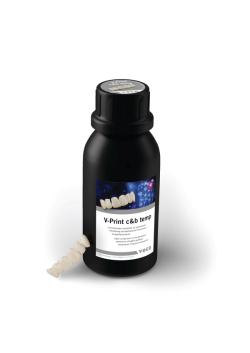- About Us
- Advertise
- Editorial
- Contact Us
- Terms and Conditions
- Privacy Policy
- Do Not Sell My Personal Information
© 2025 MJH Life Sciences™ and Dental Products Report. All rights reserved.
4 big benefits of resin cements
Thanks to new advancements, resin cements have made restoration placement easier, stronger and more esthetic.
More than a century ago, zinc phosphate was clinicians’ only choice as a luting agent. As one would expect, technologies and chemistries have changed, offering doctors better cementation options. Recently, resin cements have made restoration placement easier, stronger and more esthetic.
“Dental cements have evolved over the years,” says Dr. Liang Chen, director R&D, BISCO Dental Products. “Nowadays, the most popular cements used in dentistry include glass ionomer cements, self-adhesive resin cements and adhesive resin cements (also simply called ‘resin cements’). They each have their own advantages and disadvantages, which is why they are all still being used and probably will be used for a very long time in the future. Resin cement is used for bonding procedures and needs to be used with bonding agents (it requires one or two more steps and is less convenient), while self-adhesive resin cements or (resin-modified) glass ionomer cements do not require a bonding agent.”
Related reading: 5 tips for ideal resin cement selection
Resin cements offer clinicians a number of advantages when compared to other bonding agents in areas such as performance and esthetics.
“Resin cements have better physical properties than other products that are used for cementation or luting procedures, such as zinc phosphate and glass ionomers,” says Dr. Rolando Nunez, DDS, clinical affairs manager, BISCO Dental Products. “They are not as water soluble, or maybe soluble at all. They have better flexural modulus, fracture toughness. They’re more resistant.”
Hydrophobia
A very desirable feature of resin cement is that it does not react with water. That is, it will not be adversely affected when used in the mouth, thus making it more resilient.
“They tend to be hydrophobic, and they are not soluble,” Dr. Nunez says. “So, they will not cause damage to the resin layer that you have in there. They are very stable. They do a very good job of being able to withstand the effect of water being in the oral environment.
“It’s the nature of the material,” he adds. “It’s polymer-based, and dental polymers are hydrophobic by nature.”
“Unlike traditional cement or (resin- modified) glass ionomer cement, resin cement is not water soluble, so the restorations with resin cements will last longer,” Dr. Chen adds.
Weakening is not the only adverse effect that can occur in the oral environment. Sorption - the taking up or bonding of one substance to another - is an added effect that hydrophobic materials avoid.
More from the author: Top 10 worst states to be a dentist
“Unlike traditional cement, glass ionomer cement or self-adhesive resin cement, resin cement has a very low (almost zero) water sorption, so it doesn’t expand over time,” Dr. Chen says. “Some cements, such as glass ionomer cements, will absorb water, expand and create hydroscopic expansion stress, which may sometimes crack weak restorations (such as porcelain). Resin cement does not have this issue.”
Continue to page two to read more...
Strength
Clinicians, obviously, want the strongest, most durable bond possible, and the formulation of resin cements makes them strong and long-lasting materials.
“The cement is designed to be a composite material,” Dr. Nunez says. “It will have a filler and the resin monomer. The fillers will have an impact on the physical properties. When you compare the physical properties of a resin-based cement to other cements, like glass ionomer, zinc phosphate, carboxylic cements, they are superior. They are stronger. They are more stable, and this is due to the nature of the material.
Read more: How to use resin cements to bond indirect restorations
“Even though glass ionomers have fillers, they are weaker,” he continues. “I’m not saying that they are not suited for cementation procedures - they are indicated for that - but resin-based cements are stronger.”
While the physical capabilities of resin cements make this possible, they also do so without the clinician having to expend excessive amounts of time and energy on preparation, preserving more of the patient’s tooth structure.
“Resin cements, used with a bonding agent, provide the strongest bond strength,” Dr. Chen explains. “Clinicians can use resin cements to bond any indirect restorations. Clinicians do not have to grind down teeth to make a retentive prep; they can just rely on the strong bond strength that resin cement (with a bonding agent) provides.”
That ability with resin cements may be somewhat of a paradigm shift for some doctors.
“There is a very well-known saying, ‘If all you have is a hammer, then everything looks like a nail,’” Dr. Chen says. “In dentistry, I would like to say, ‘If all you know is luting a retentive crown, you will start grinding teeth and making retentive preps for every patient.’ Resin cements (with bonding procedure) provides freedom for the dentist to choose the best restoration for patients with a minimally invasive procedure.”
But doctors have choices. Depending on the location of the restoration and the doctor’s work style, the process can be simplified even further.
Trending research: Can tooth loss lead to cardiovascular disease?
“When we talk about self-adhesive resin cements, they do not require a bonding agent to be placed beforehand on the preparation,” Dr. Nunez explains. “It’s not required because the cement itself has the bonding ability. So, you are saving one step, which sometimes can be cumbersome because bonding to a prep can be difficult, depending on isolation and the location of the preparation and all that. So, by using a self-adhesive cement, you don’t need to place a bonding agent. It is more like a glass ionomer-type of cement but with all the properties and the features of a resin-based cement. You have the best of both worlds, so it is a very, very nice product to have in the office.”
Continue to page three to read more...
Esthetics
Naturally, patients want quality, durable and long-lasting restorations. However, when they are looking in the mirror, the most important concern is not going to be whether the restoration is particularly strong or whether it will hold up over time. They are, not surprisingly, more interested in how the restoration looks.
While cements on their own are not major players in a restoration’s looks, if used poorly, they can have a detrimental effect. Fortunately, resin cements do provide features for high-quality esthetics.
More from the author: 5 things you need to know about personal protective equipment
“The shading and the translucency are going to have an impact on the esthetics.” Dr. Nunez says.
That coloring and opacity – during both the initial placement and over time - are another of resin cement’s strong suits.
“Resin cements normally have a better esthetic feature and better color stability,” Dr. Chen says.
Resin cements come in a wide range of shades too, affording doctors the best possible outcomes.
“The good thing about resin-based cements is that they come in a vast array of shades,” Dr. Nunez says. “The nomenclature of the shades can be VITA, which all dentists are familiar with, with different levels of translucency. That allows for the clinician to incorporate that other feature into their cementation procedure, which sometimes is very important, especially when you’re working in the anterior region, to achieve proper esthetics. Resin-based cement will help the clinician to achieve proper esthetics due to the different shades that are available.”
Handling
Key to the best outcomes is how well a product handles. That is, clinicians must to be able to properly place the material with ease and predictability. Resin cements, Dr. Nunez says, provide that ease of handling while delivering the best conditions for a restoration.
“They also have good flowability,” Dr. Nunez says. “Flowability allows us to achieve a low film thickness, which will not interfere in the proper seating of the crown or restoration that is being cemented. So, when you have that kind of property, from a physical point of view, they are better.”
The viscosity of resin cement makes it easy to both handle and place the final restoration.
“It comes at a flowable presentation,” Dr. Nunez says. “When you deliver the cementation or restoration into the prep, the cement will flow because of its viscosity. It will flow and seal, but it will be thin enough that it will not interfere with the proper seating of that restoration. And if you use something that is too viscous, and you try to push it down while you try to seat that restoration properly, and that product is not able to flow, you might interfere. But, for the most part, all cements, or all products that are used for cementation procedures, flow. That’s a given for all cements, but resin-based cements flow nicely and they will not interfere with the proper seating.”
Related reading: How to create restorations that look great seven years later
Products with the right consistency – like resin cement – afford clinicians the characteristics necessary for the best restorative outcomes.
“With handling, it’s always better to have a flowable,” Dr. Nunez says. “You want that viscosity and it definitely helps the clinician.”
As with so many things in dentistry, clinicians now have more bonding options than ever before. They can find the agent with the characteristics that best match a case’s needs, the doctor’s work style and, ultimately, the interests of the patient. Resin cements afford the clinician a number of benefits, not the least of which are exceptional outcomes.
“Resin cements can provide a minimally invasive procedure to achieve a longer lasting restoration with a better esthetic outcome,” Dr. Chen observes. “Resin cements offer clinicians freedom to bond any type of restorations.”



